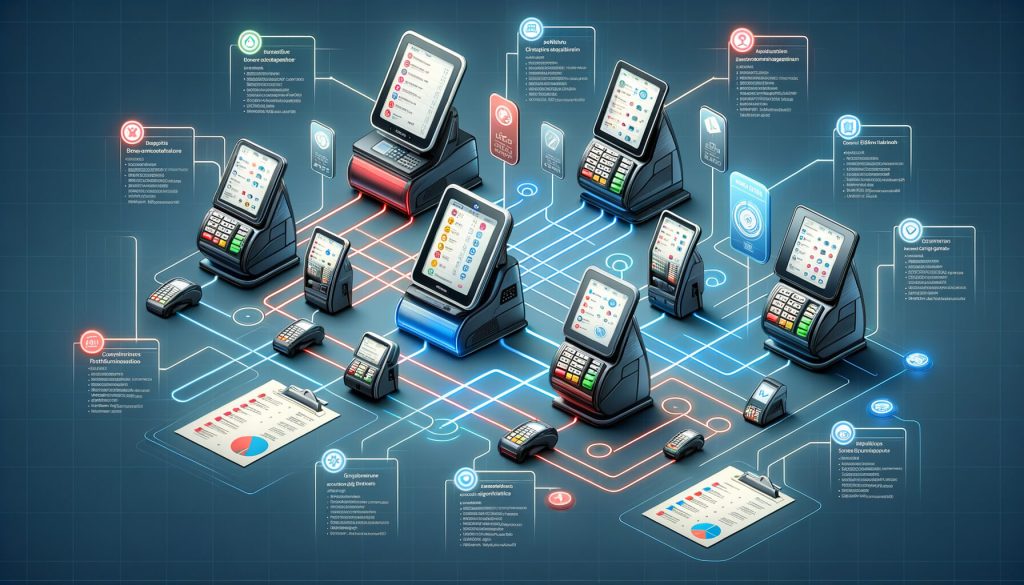
By Ethan Brooks November 3, 2024
Electronic Benefit Transfer (EBT) is a system that allows recipients of government assistance programs, such as the Supplemental Nutrition Assistance Program (SNAP), to access their benefits through a card similar to a debit or credit card. EBT transactions are processed through a Point of Sale (POS) system, which is a software and hardware solution used by merchants to facilitate sales and manage transactions.
In this article, we will explore how to effectively manage EBT transactions with your POS system. We will cover topics such as setting up your POS system for EBT transactions, understanding EBT program rules and regulations, accepting EBT payments, troubleshooting common issues, maximizing efficiency, enhancing security, and managing reporting and record-keeping. By following these guidelines, merchants can ensure a smooth and compliant EBT transaction process.
Understanding the Benefits of Using a POS System for EBT Transactions
- Streamlined Operations: A POS system automates the process of handling EBT transactions, eliminating the need for manual calculations and reducing the chances of errors. This streamlines operations and saves time for both the business and the customer.
- Enhanced Customer Experience: With a POS system, customers can easily use their EBT cards to make purchases, just like any other payment method. This improves the overall shopping experience and ensures that customers can access their benefits conveniently.
- Real-Time Reporting and Analytics: A POS system provides businesses with real-time reporting and analytics, allowing them to track EBT transactions, monitor sales, and analyze customer behavior. This data can be used to make informed business decisions and optimize operations.
- Integration with Inventory Management: Many POS systems offer integration with inventory management software, enabling businesses to track EBT-eligible items, manage stock levels, and automate reordering processes. This integration ensures that businesses can efficiently manage their inventory and meet customer demands.
- Compliance with Government Regulations: Using a POS system for EBT transactions helps businesses comply with government regulations and ensures that all transactions are accurately recorded and reported. This reduces the risk of penalties and audits.
Choosing the Right POS System for EBT Transactions

When selecting a POS system for managing EBT transactions, there are several factors to consider:
- EBT Compatibility: Ensure that the POS system is compatible with EBT transactions and can process them seamlessly. Look for systems that have been certified by the appropriate government agencies.
- User-Friendly Interface: Opt for a POS system with an intuitive and user-friendly interface. This will make it easier for employees to learn and use the system effectively, reducing training time and potential errors.
- Integration Capabilities: Consider whether the POS system can integrate with other software and hardware, such as inventory management systems, payment processors, and barcode scanners. Integration capabilities enhance efficiency and streamline operations.
- Scalability: Choose a POS system that can grow with your business. Consider whether it can handle an increasing number of transactions, support multiple locations, and accommodate future expansion plans.
- Customer Support and Training: Evaluate the level of customer support and training provided by the POS system provider. Ensure that they offer comprehensive training materials, responsive customer support, and regular software updates.
Setting Up Your POS System for EBT Transactions
Once you have chosen the right POS system for managing EBT transactions, it is essential to set it up correctly. Follow these steps to ensure a smooth setup process:
- Install and Update Software: Install the POS system software on your devices, such as cash registers, tablets, or smartphones. Ensure that you have the latest version of the software to benefit from any bug fixes or new features.
- Configure EBT Settings: Access the system settings and configure the EBT settings according to your business requirements. This may include setting up EBT payment options, tax rates, and item eligibility for EBT transactions.
- Train Employees: Provide comprehensive training to your employees on how to use the POS system for EBT transactions. Cover topics such as processing EBT payments, handling refunds, and troubleshooting common issues.
- Test the System: Before going live, conduct thorough testing of the POS system to ensure that it is functioning correctly. Test various scenarios, such as different EBT card types, transaction amounts, and item eligibility.
Processing EBT Transactions with Your POS System: Step-by-Step Guide

Now that your POS system is set up, let’s walk through the step-by-step process of processing EBT transactions:
- Customer Selection: When a customer wants to make a purchase using their EBT card, select the EBT payment option on the POS system. This may be a dedicated button or a dropdown menu.
- Card Swipe or Entry: Ask the customer to swipe their EBT card through the card reader or manually enter the card number using the POS system’s keypad. Ensure that the card information is accurately entered.
- PIN Entry: Prompt the customer to enter their Personal Identification Number (PIN) associated with their EBT card. The POS system should securely process and verify the PIN.
- Item Selection: Scan or manually enter the items the customer wishes to purchase. The POS system should automatically determine the eligibility of each item for EBT payment based on the configured settings.
- Transaction Total: Once all items are scanned or entered, the POS system will calculate the total amount of the transaction, including any applicable taxes. This total should reflect the eligible items for EBT payment.
- Payment Authorization: Initiate the payment authorization process by sending the transaction details to the EBT processing network. The POS system will communicate with the network to verify the customer’s available balance and authorize the payment.
- Customer Confirmation: Once the payment is authorized, inform the customer of the transaction’s success and provide them with a receipt. The receipt should clearly indicate the items purchased, the total amount paid with EBT, and any remaining balance.
Ensuring Compliance and Security in EBT Transactions with Your POS System

Compliance and security are crucial when managing EBT transactions with a POS system. Follow these best practices to ensure compliance and protect sensitive customer information:
- Secure Network: Ensure that your POS system is connected to a secure network, preferably a dedicated network for payment processing. Implement firewalls, encryption, and other security measures to protect against unauthorized access.
- PCI DSS Compliance: The Payment Card Industry Data Security Standard (PCI DSS) sets guidelines for securely handling payment card data. Ensure that your POS system is PCI DSS compliant and follow the recommended security practices.
- Employee Access Control: Limit access to the POS system and EBT transaction data to authorized employees only. Implement user accounts with unique login credentials and assign appropriate access levels based on job roles.
- Regular Software Updates: Keep your POS system software up to date with the latest security patches and bug fixes. Regularly check for updates from the system provider and promptly install them to protect against vulnerabilities.
- Data Encryption: Ensure that all EBT transaction data transmitted between the POS system and the EBT processing network is encrypted. Encryption adds an extra layer of security and prevents unauthorized interception of sensitive information.
Accepting EBT Payments: Step-by-Step Guide for Merchants
Accepting EBT payments with your POS system is a straightforward process. Here is a step-by-step guide to help you navigate through the transaction:
- Customer presents their EBT card: When a customer wishes to pay with EBT, they will present their EBT card to the cashier.
- Cashier selects EBT payment option: The cashier will select the EBT payment option on the POS system. This may be a dedicated button or a dropdown menu, depending on your POS system’s interface.
- Card insertion or swipe: The cashier will either insert the EBT card into the card reader or swipe it, depending on the type of card reader you have. Some modern POS systems also support contactless payments, allowing customers to tap their EBT card on the reader.
- PIN entry: The customer will be prompted to enter their Personal Identification Number (PIN) associated with their EBT card. The cashier should ensure that the customer enters their PIN securely and privately.
- Transaction approval: Once the PIN is entered, the POS system will communicate with the EBT program’s servers to verify the transaction. If the transaction is approved, the customer’s EBT balance will be deducted, and the sale will be completed.
- Receipt generation: The POS system will generate a receipt for the customer, indicating the details of the transaction, including the remaining EBT balance, if applicable.
Troubleshooting Common Issues with EBT Transactions on Your POS System

Managing EBT transactions with your POS system can be a seamless process, but like any technology, it can sometimes present challenges. Understanding how to troubleshoot common EBT transaction issues is crucial for ensuring smooth operations and maintaining customer satisfaction. One of the most frequent issues encountered is connectivity problems.
EBT transactions require a stable internet connection, and any disruption can lead to transaction failures. To address this, ensure that your POS system is connected to a reliable network. Regularly check your internet connection and consider having a backup connection in place to prevent disruptions.
Another common issue is incorrect card reader configurations. If the card reader is not properly set up, it can lead to transaction errors. To troubleshoot this, verify that the card reader is correctly connected to the POS system and that all necessary software updates have been installed. Additionally, ensure that the card reader is compatible with EBT transactions, as not all devices support this functionality.
Transaction declines can also occur due to insufficient funds in the customer’s EBT account. In such cases, it is important to communicate clearly with the customer, explaining the reason for the decline and suggesting they check their account balance. Providing a discreet and respectful approach can help maintain a positive customer experience.
Occasionally, EBT transactions may be declined due to system errors or glitches. When this happens, it is advisable to retry the transaction. If the issue persists, contact your POS system provider for technical support. They can offer guidance on resolving the issue and may provide software updates or patches to fix any underlying problems.
Moreover, training your staff on handling EBT transactions and troubleshooting common issues is essential. Well-trained employees can quickly identify and resolve problems, minimizing disruptions and ensuring efficient service. Regular training sessions and updates on system changes can empower your team to manage EBT transactions effectively.
In addition to these technical aspects, maintaining compliance with EBT regulations is crucial. Ensure that your POS system is certified for EBT transactions and that you adhere to all relevant guidelines. Non-compliance can lead to penalties and the loss of the ability to process EBT transactions, which can significantly impact your business.
Furthermore, keeping detailed records of EBT transactions can aid in troubleshooting and resolving disputes. Accurate records allow you to track transaction history and identify patterns or recurring issues. This information can be invaluable when working with your POS provider to address technical problems or when responding to customer inquiries.
Maximizing Efficiency: Tips for Streamlining EBT Transactions
Efficiency is crucial when managing EBT transactions with your POS system. Here are some tips to help streamline the process:
- Train your staff: Properly train your staff on how to process EBT transactions efficiently. This includes familiarizing them with the POS system’s EBT functionality, understanding the rules and regulations, and troubleshooting common issues.
- Optimize your POS system’s layout: Customize your POS system’s interface to prioritize the EBT payment option. This will make it easier for cashiers to locate and select the EBT option quickly.
- Utilize shortcut keys: If your POS system supports shortcut keys, assign a key combination to the EBT payment option. This will allow cashiers to process EBT transactions with a simple key press, reducing the time spent navigating through menus.
- Implement barcode scanning: If your store uses barcodes for product scanning, consider implementing barcode scanning for EBT cards. This can significantly speed up the transaction process by eliminating the need for manual card insertion or swiping.
Enhancing Security: Best Practices for EBT Transaction Management
Security is of utmost importance when managing EBT transactions. Here are some best practices to enhance security:
- Protect customer PINs: Train your staff to ensure that customer PINs are entered securely and privately. Cashiers should never ask customers to disclose their PINs or handle their EBT cards unnecessarily.
- Regularly update your POS system: Keep your POS system’s software up to date with the latest security patches and updates. This will help protect against potential vulnerabilities and ensure that your system is equipped with the latest security features.
- Implement user access controls: Restrict access to EBT transaction functionality to authorized personnel only. Implement user accounts with unique login credentials and assign appropriate access levels based on job roles and responsibilities.
- Monitor for suspicious activity: Regularly review transaction logs and reports for any unusual or suspicious activity. If you notice any discrepancies or potential fraud, report it to the appropriate authorities and your payment processor immediately.
Reporting and Record-Keeping: Managing EBT Transactions with Your POS System
Accurate reporting and record-keeping are essential for managing EBT transactions effectively. Here are some tips for managing reporting and record-keeping with your POS system:
- Generate detailed transaction reports: Utilize your POS system’s reporting capabilities to generate detailed transaction reports. These reports should include information such as transaction date and time, transaction amount, EBT card number, and any other relevant details.
- Retain transaction receipts: Keep a copy of each transaction receipt for the required period. This will serve as proof of the transaction and can be used for reconciliation purposes or in the event of an audit.
- Reconcile EBT transactions regularly: Compare your EBT transaction records with your settlement reports to ensure that all transactions are accounted for. Any discrepancies should be investigated and resolved promptly.
- Backup your data: Regularly backup your POS system’s data, including transaction records and reports. This will help protect against data loss due to hardware failure, software glitches, or other unforeseen circumstances.
Frequently Asked Questions (FAQs)
Q1: Can I accept EBT payments without a POS system?
No, a POS system is required to process EBT transactions. It is recommended to invest in a modern POS system that supports EBT functionality for a seamless transaction process.
Q2: Can I accept EBT payments online?
Currently, EBT payments can only be accepted in-person at physical retail locations. Online EBT payment acceptance is not yet widely available.
Q3: How long should I retain EBT transaction records?
The specific record retention period may vary depending on your location and the EBT program rules. Generally, it is recommended to retain EBT transaction records for a minimum of two years.
Q4: Can I offer cash back with EBT transactions?
No, cash back is not allowed with EBT transactions. EBT benefits can only be used to purchase eligible food items.
Q5: What should I do if my POS system is not processing EBT transactions correctly?
If you are experiencing issues with your POS system’s EBT functionality, contact your POS system’s support team for assistance. They will be able to troubleshoot the issue and provide guidance on resolving it.
Conclusion
Managing EBT transactions with your POS system requires careful setup, compliance with program rules and regulations, and efficient transaction processing. By following the steps outlined in this article, merchants can ensure a smooth and compliant EBT transaction process.
Remember to train your staff, optimize your POS system’s layout, enhance security measures, and maintain accurate reporting and record-keeping. By doing so, you can provide a seamless experience for customers using EBT benefits while maintaining compliance with program requirements.